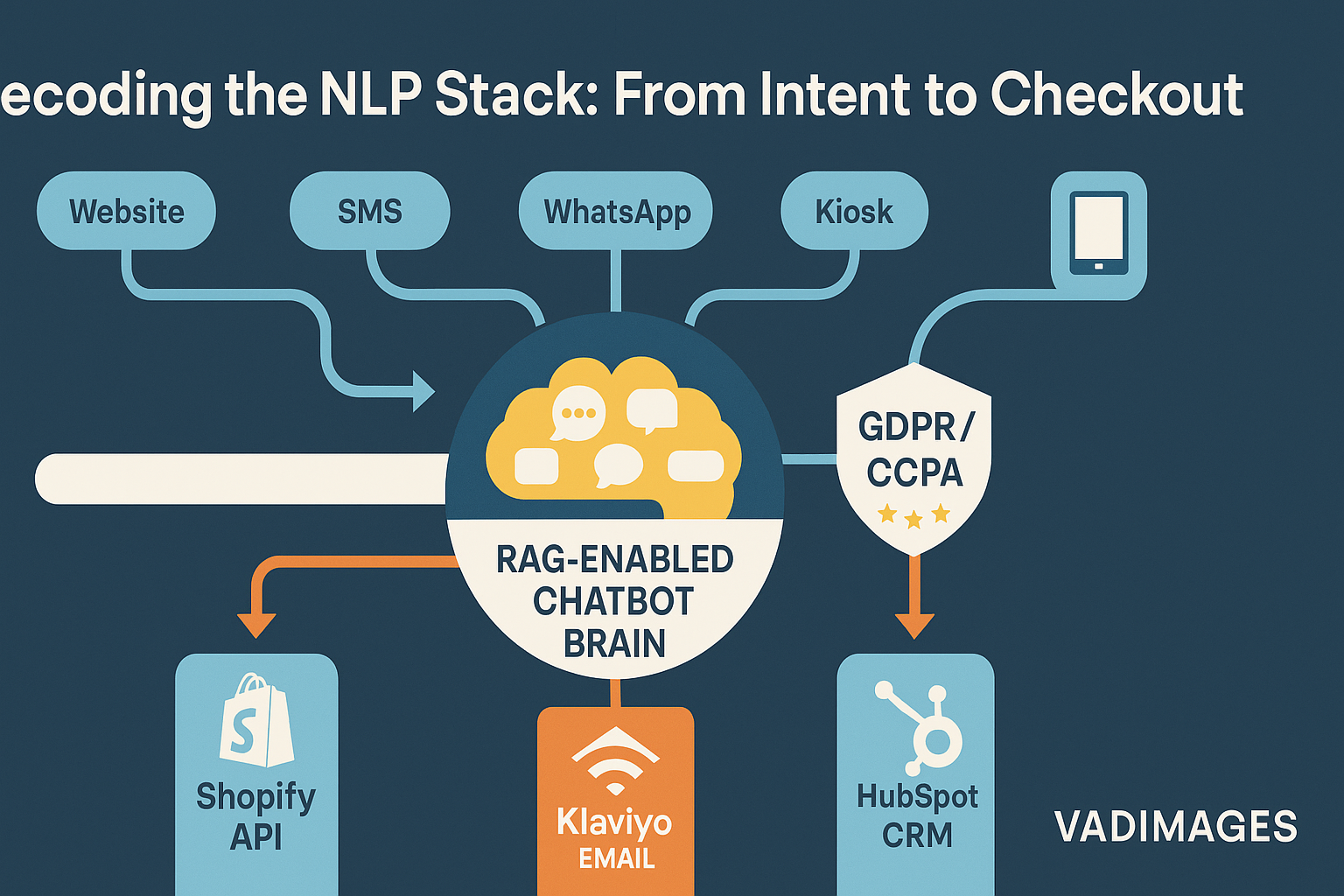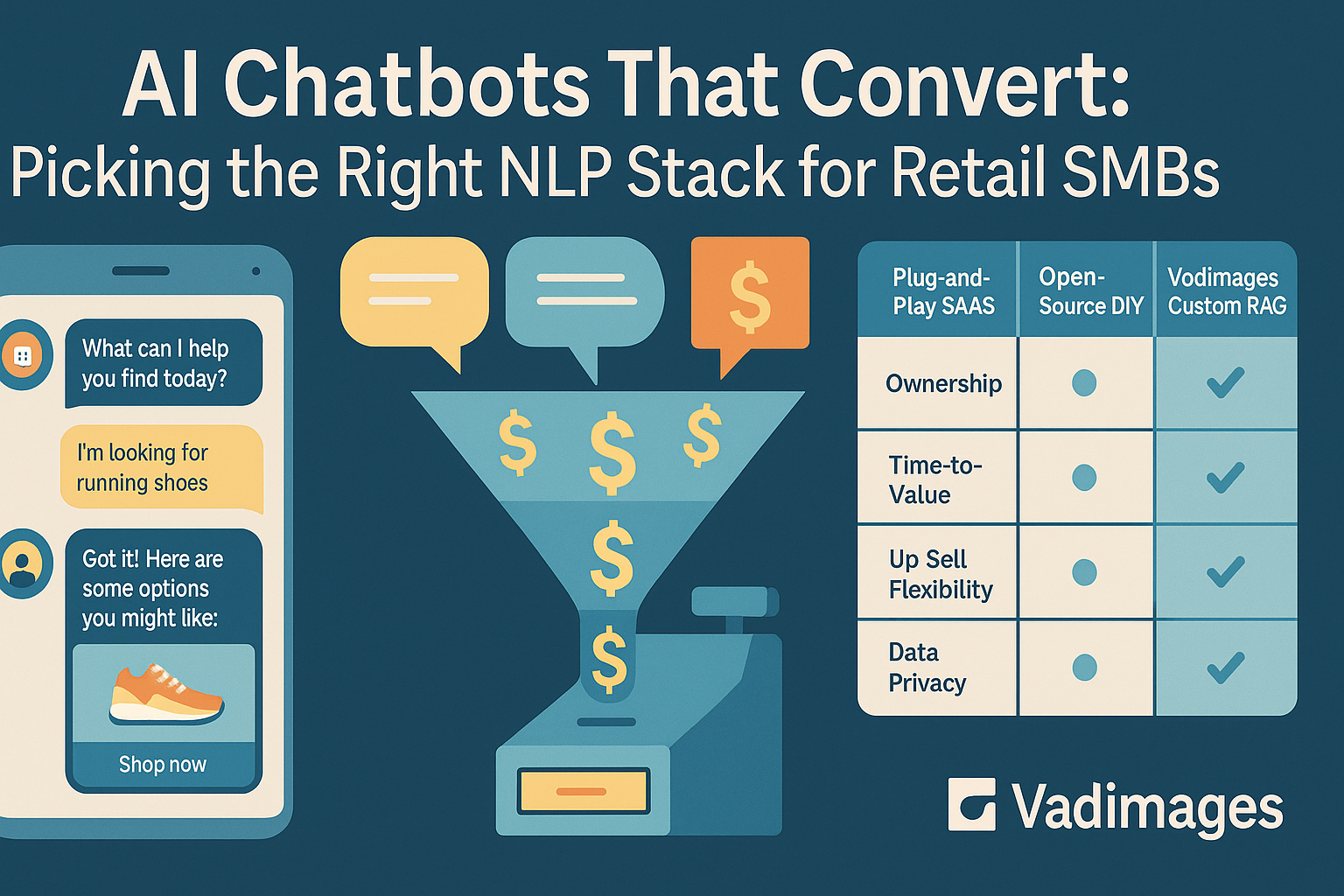
Why Retailers Still Struggle With “Helpful” Chatbots
E-commerce founders have dreamt of friction-free conversations since the first live-chat widget blinked online, yet many deployments still feel canned, intrusive, or plain ignorant of inventory reality. Small and midsize retailers hesitate because one bad interaction can echo across social channels as loudly as a five-star review. Their Google journeys—often phrased as “best AI chatbot for small business website”—reveal a desire for accessible tech that behaves with the empathy of a seasoned floor associate while driving measurable revenue. Conversational commerce is no longer hype: Shopify reports that 47 percent of shoppers expect instant answers, and Salesforce notes that buyers who chat convert at double the rate of silent browsers. The competitive gap grows wider each quarter a storefront waits to act.
Decoding the NLP Stack: From Intent to Checkout
Natural-language understanding has matured into modular layers that can be mixed like LEGO® bricks. At the top sit the large language models—OpenAI GPT-4o or Google Gemini—that transform messy customer questions into structured intents such as “find red size-8 sneakers” or “track my order.” A policy layer then maps intent to business logic: it checks Magento, BigCommerce, or Shopify APIs, pulls real-time stock, suggests alternate SKUs if that size is gone, and, crucially, keeps the context so the shopper never repeats herself. Below that, a vector database such as Pinecone or Weaviate stores product descriptions and historical Q&A, empowering semantic retrieval beyond rigid keywords. When stitched together with an orchestration framework—think LangChain, RAG pipelines, or a light Rust microservice—a retailer gains a brain that remembers, reasons, and upsells.

Choosing between turnkey SaaS and custom orchestration hinges on ownership and scale. Out-of-the-box tools like Intercom Fin or Gorgias AI minimize setup but lock data and conversational tone to vendor templates. Custom RAG stacks trained on your exact catalog and brand voice demand more engineering yet unlock deeper product matchmaking, cross-sell rules, and smoother hand-offs to human agents when sentiment sours.
Measuring What Matters: Conversion Over Chit-Chat
Beyond helpful answers, an NLP stack must feed the bottom line. Our deployments at Vadimages show three metrics separate winners from toys. First is Assisted Conversion Rate, the percentage of chat-initiated sessions ending in checkout; elite bots surpass ten percent. Second is Average Order Value uplift, quantifying how recommendations nudge complementary items into carts. Third is First Response Latency, because if the bot spends ten seconds thinking, the customer spends five seconds leaving. With proper instrumentation, retailers can A/B test language prompts, tone, and exit criteria just as they optimize landing pages. Continuous training on anonymized transcripts ensures the system learns regional slang and seasonal item nicknames—vital for U.S. holiday shoppers hunting for “ugly sweater kits” in December.
The Vadimages Approach: Conversational Commerce Without the Headaches
Vadimages specializes in custom NLP stacks that respect small-business budgets while punching above generic SaaS. We begin by auditing your catalog taxonomy and existing support tickets to seed an intent library grounded in the way your customers already speak. Our engineers then deploy a hybrid cloud architecture: OpenAI functions for generative reasoning, a cost-efficient open-source embedding model for retrieval housed on an AWS Graviton instance, and a Rust-based policy handler that interfaces with your e-commerce backend. The result is a chatbot fluent in your brand story, capable of quoting real-time shipping ETAs, upselling warranty bundles, and switching to live agents inside Zendesk when frustration is detected. Integration typically ships in six weeks, including ADA-compliant front-end widgets built with Next.js and Tailwind CSS.

Every project is wrapped in a growth-oriented service agreement: quarterly prompt-tuning, funnel diagnostics, and marketing copy refreshes ensure your bot evolves alongside your catalog. For merchants using retail POS, our webhook layer mirrors in-store inventory so the bot never promises an item that just sold out at the brick-and-mortar counter.
Ready to Speak Your Customer’s Language?
Conversational commerce will not wait for the next budgeting cycle. Shoppers already treat chat as the first aisle they walk down; if your site stays silent, they will ask a competitor. By investing in a right-sized NLP stack now, retail SMBs transform chat from cost center to top-line engine, building loyalty one helpful answer at a time. Vadimages stands ready to translate AI into revenue with transparent pricing, white-glove onboarding, and U.S.-based compliance expertise.


Leave a Reply
You must be logged in to post a comment.